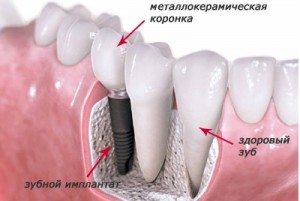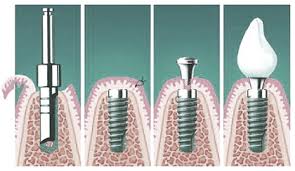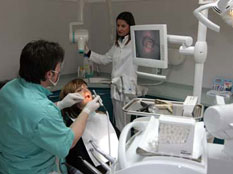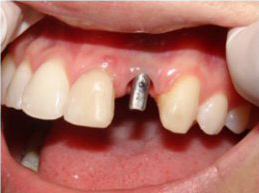Two-stage dental implantation

Today, there are two methods of implantation - traditional (classical) or two-stage dental implantation and one-stage.
Each of these methods has its advantages and disadvantages.
The name of the two-stage implantation is not given by chance.
At the first stage of implantation, the implant is implanted, and at the second stage, after successful implantation, the abutment is installed, which is the intermediary between the implant and the future prosthesis.
Benefits
The installation of implants in two stages has the advantages:
- The most reliable and proven way.
- It is characterized by the highest percentage of engraftment of titanium structures.
- Minimal risk of implant rejection.
- Allows you to restore both one tooth and multiple tooth loss.
- The implant installed by the two-stage method prevents bone tissue atrophy and stimulates its formation around itself.
- Implants can serve as a support for removable dentures, thereby improving their fixation.
- It gives a good aesthetic effect.
disadvantages
The main disadvantages of two-stage implantation:

- A long period of implant fusion with the jaw bone.
- The need for regular visits to the dentist in the postoperative period throughout the entire period of engraftment of the structure.
- Prosthetics is possible only after the abutment is installed.
The classical implant implantation procedure implies:
- Implantation of a dental implant in the jawbone, sometimes with a preliminary increase in bone volume. After the implant is installed, suturing is performed with further engraftment of the implant for several months.
- At the end of osseointegration, a gingiva former is attached to the implant, and then an abutment, on which the denture is fixed.
- In case of atrophic changes in bone tissue, implantation may be preceded by bone grafting. In acute deficiency of bone tissue, its volume is first increased, and only after bone maturation, titanium structures are implanted.
- With a two-stage technique, it is impossible to load the implant, the installation of the crown is possible no earlier than two months.
- If it is not possible to install the implant in the hole of the extracted tooth, you must wait until it completely closes (this will happen within 2 to 3 months). Only after closing the hole is implantation of the titanium root in a standard way.
Video: “Installation of the implant”
Stages
The first stage is a comprehensive examination of the patient
Allows you to identify the presence of contraindications for surgical intervention.
At this stage, it is carried out:

- Consultation by an orthopedist and surgeon who, on the basis of x-ray and computed tomography, will evaluate the condition of the bone tissue, and they will select the exact implant system that suits this patient.
- Sanitation of the oral cavity, which includes the treatment of caries, removal of mobile, completely destroyed and unsuitable for prosthetics teeth.
- Anamnesis and examination of the patient in order to identify contraindications to the installation of implants. Consultation of specialists in case of detection of chronic diseases in a patient and their treatment.
The second stage is surgical
How is implantation carried out:
- The operation is performed under local anesthesia.
- An incision of the gum is made with its subsequent exfoliation.
- Using mills, a bed under the implant is formed.
- Screw-in implant with controlled force.
- The stub is locked.
- Suturing the gums.
- Stitches are removed in a week.
Stage 2 of the operation lasts from 20 minutes to an hour.
- An implant implanted in the jaw does not come into contact with the oral cavity, because it is located inside the bone and is completely sutured by the mucosa.
- The implant engraftment lasts from two to six months.
After osseointegration of the implant with the bone, they proceed to the next stage.
Gingiva Shaper Installation
Allows you to form the correct gingival contour.

- Using a small incision, the implant is opened.
- After that, the gingiva former or abutment with a temporary crown, which plays the role of the former, is fixed on it. Then, healing takes place within 7 to 10 days.
- Subsequently, an abutment is installed in place of the former.
This completes the surgical implantation phase.
From the moment the abutment is fixed, the third stage begins - dental prosthetics.
Prosthetics - the final stage of implantation
- Imprints are made from the jaws.
- A dental prosthesis is made in the dental laboratory.
- Fixation of a fixed denture on implants is carried out using dental cement.